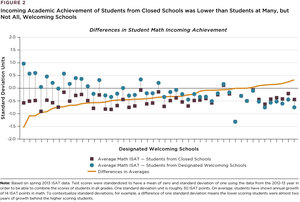1. How did staff and students affected by school closings experience the school closings process and subsequent transfer into designated welcoming schools?
2. What effect did closing schools have on closed and welcoming schools students’ mobility, attendance, suspensions, test scores, and core GPAs?
The qualitative portion of this mixed-methods study used data from interviews with staff and students at six designated welcoming schools, selected to represent a range of transition experiences. In interviews, staff and students from both closed and welcoming schools reported that the planning process for merging schools was not sufficient, resulting in feeling unprepared for the start of the school year. In addition, interviewees used the word “chaotic” to describe the process of moving schools, saying it was difficult to adequately prepare schools in time to receive students. Staff and students reported experiencing a period of mourning, not only because the closings process severed longstanding social connections, but also because the merging of school cultures created challenging social dynamics. Staff and students said they appreciated the expansion of Safe Passage routes, and new investments in technology and resources.
The quantitative portion of the study used administrative data from 2008-09 through 2016-17 for all students in the closed and welcoming schools. It compared closed and welcoming school students’ mobility, attendance, suspensions, core GPA, and test scores after the closings to their prior outcomes and to those of students in similar schools to understand the effect of the closings. It found mobility increased among students attending welcoming schools that relocated in to the building of a closed school; those students were more likely to transfer to other schools in the year of the merger. In subsequent years, mobility was not affected by the closures for students in closed or welcoming schools. There was no effect on absence or suspension rates for students in closed or welcoming schools. Core GPA was not affected immediately after the closures, although there were small negative effects three and four years post-closures for students from closed schools who had been in the grades 3-5 in the announcement year (2012-13). While these students' GPAs were lower than expected, their GPAs were improving over time. The test scores of students in both closed and welcoming schools were negatively affected. Students from closed schools experienced the largest negative effect. Their scores were lower than expected in the year of the announcement: roughly 1.5 months in reading and 2 months in math. Reading scores recovered after one year, but the negative effect on math scores persisted for four years (the last year of data in the study). Students from welcoming schools showed lower reading test scores, about 1.5 months lower than expected, the first year after the merger. This was a short-term effect, as reading scores rebounded the following year.
Prior research on school closings in other districts has also found negative effects on students’ outcomes in the year that the closings are announced. Other studies generally find lower attendance and higher subsequent mobility, as well as some negative effects on the achievement of students in receiving schools. Researchers found that these effects were mitigated when students from closed schools attend substantially better performing receiving schools, or when there is less disruption for students, such as when schools are phased-out. The findings from this current study differ somewhat from other research because it found the negative effect on students’ math scores persisted four years after schools were closed, however, attendance and mobility were not affected for displaced students.






